 |
UMBRIA |
 Back to Italy |
| Provinces
- Regione formata da 2 province: Perugia, Terni Chief town - Perugia Surface- kmq 8456 National Parks - National Park of Mountain Sibillini (1990)  Russian Version |
 |
|
|
||
 |
UMBRIA |
 Back to Italy |
| Provinces
- Regione formata da 2 province: Perugia, Terni Chief town - Perugia Surface- kmq 8456 National Parks - National Park of Mountain Sibillini (1990)  Russian Version |
 |
|
|
||
 |
Origin of the Name |
| Reliefs - Passes - Coasts - Islands | |
| Landscape | |
| Agriculture - Stock-Farm - Fishing | |
| Industry - Tourism | |
| Position and Frontier | |
| Rivers - Lakes | |
| Climate | |
| Population | |
| Communication |
Origin of the name:
Originally in this Region lived two ancient italic
people: Umbris and Etruschis. To the Roman epoch of August emperor, that
determined the confinements, this Region was extended up to the adriatic coast
of the Marche and to west it left to Etruria the zone of Lake Trasimeno. After
the fall of the empire Romano the Region was divided between Longobardis and
Byzantines. In the time these zones remained always uniforms in so many small
states, among which became the Dominions of Monferratos and Malatestas very
powerful.
Reliefs - Passes - Coasts -
Islands:
The greatest mountainous chain of Umbria is given by
Appennino Umbro-Marchigiano, situated to the border with Marche. The expanse of
Appennino is extended by the pass of the Mouth Trabaria to Pitchfork Capine up
to climb to Sibillinis Mountains, in which we find the tallest peak that is
Vector Mountain with his 2478 ms. ; going down toward the basin of Lake
Trasimeno and the valley of Tevere are found more steep walls and tops very
round off. Over Tevere, parallel to the mountains of Antiappennino tosco and
laziale, other less important mountainous chains are found and not very tall
that limit the border of south and southeast. Between the high ground
appenniniche and those antiappenniniches, find more or less numerous great
basins, almost level. The principal level zones are the valley of Tevere called
Val Tiberina and Valley Umbra, crossed by the rivers Topino, Clitunno and
Chiascio. The valley of the zone of Tevere is born very narrow and
disconnected, but after Perugia it is regularized and it is extended in ample
green lawns. The other level zones more important are the basins of Cascia,
Norcia, Gubbio, Terni and Gualdo Tadino. These zones are very fertile and are
surrounded from hills. In the past these basins were of the lakes.
Characteristic of this green panorama is the presence of numerous sanctuaries, that testify faith since the times most distant of the population and the castles that let imagine the fierce struggles and the rivalries of the rich. Also the modern structures not missing, this region still maintains its originality in the towns, some built by the people Etruschi and Romans. During the period of the Middle Ages, were founded some free Common, that were of great importance and wealth; this has shown from the numerous public buildings and from the splendid churches built in that epoch. .
Agriculture - Stock-farm -
Fishing:
Agriculture is not flourishing in Umbria either for the
systems of cultivation withdrawn, also because the varied zones have divided in
small ownerships that have usually conducted to mezzadria. The big agricultural
concentration is situated in particular way in the valleys, in the basins and
in the western part of the Region. Between the principal crops we remember that
of the wheat that is its most diffused of the sugar beets and of the tobacco.
Small productions of wine and oil offer some products of good quality. A
particularity is the crop of the hypocrites and the most famous are those black
of Norcia. The breeding more developed it is that of the swines, while once was
existing, in the mountains, also that of sheep that today it is as
disappearing. The thick woods give the possibility of substantial supplies of
lumber.
Position and Frontier :
In the italian peninsula, the only Region that has not
bathed from the sea is really Umbria, that confines to north and to east with
Marche, to south with Lazio and to east with Lazio and Tuscany.
Rivers - Lakes:
Umbria is rich of rivers. The greatest is Tevere, that
is born from Chimney Mountain and after having crossed Tuscany it enters in the
territory of Umbria for then to continue in Lazio, where it goes to receive the
waters of its great tributary: Black river. Black river that before entering in
Tevere receives the waters of Velino forming so the famous fall of Marmore. In
Umbria we find Lake Trasimeno, little depth and its surface goes slowly
decrease. This lake for extension is the fourth of Italy. There are other more
small lakes; the most meaningful is Lake of Corbara and Lake of Chiusi situated
to the border with Tuscany.
Climate:
The Region having confined from the mountainous reliefs
it doesn't profit any influence of the sea. The climate is continental with
winters colds and warm summers. The precipitations are abundant especially in
the proximities of the chains appenniniche. Often in the basins and in
the more small level lines, in summer there is not wind and the air it is
sultry. In general Umbria enjoys of a good due climate to the rich vegetation.
Population:
In Umbria the relationship between
territory-inhabitants is under the national average. There are no big urban
agglomerations; the populated zones are those of Valley Umbra and of Basin of
Terni. The cities in these zones the 160 thousand inhabitants don't overcome.
As in almost all the regions to mountainous character there is the typical
tendency to abandon the mountainous and hilly tall zones, to move to the cities
in the lowland or to emigrate in the other regions or even abroad.
Communication:
Built above the high ground or in the necks according
to rules medioevali, that allowed to defend the cities from the attacks of
other people, today the tallest cities extend to be more and more isolate
really because they find big difficulties of communication for their urbanistic
positions. The road and railway fittings more important pass to the outside of
the Region only. The only important streets are that railway that connects
Ancona with Rome passing for Terni and Foligno and that road that from Rome it
arrives to the port of Ascoli, in Marche, touching the cities of Foligno and
Spoleto.
Web Site designed by MediaSoft - © Copyright 1998-1999 - All rights reserved